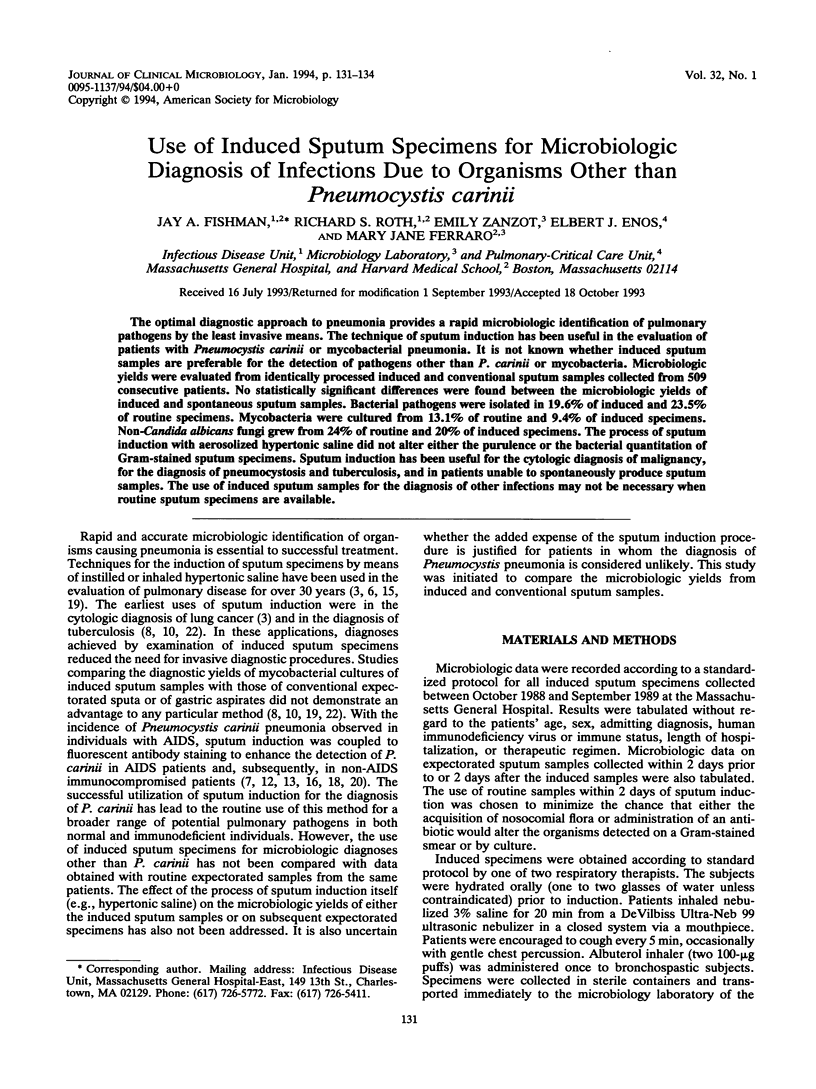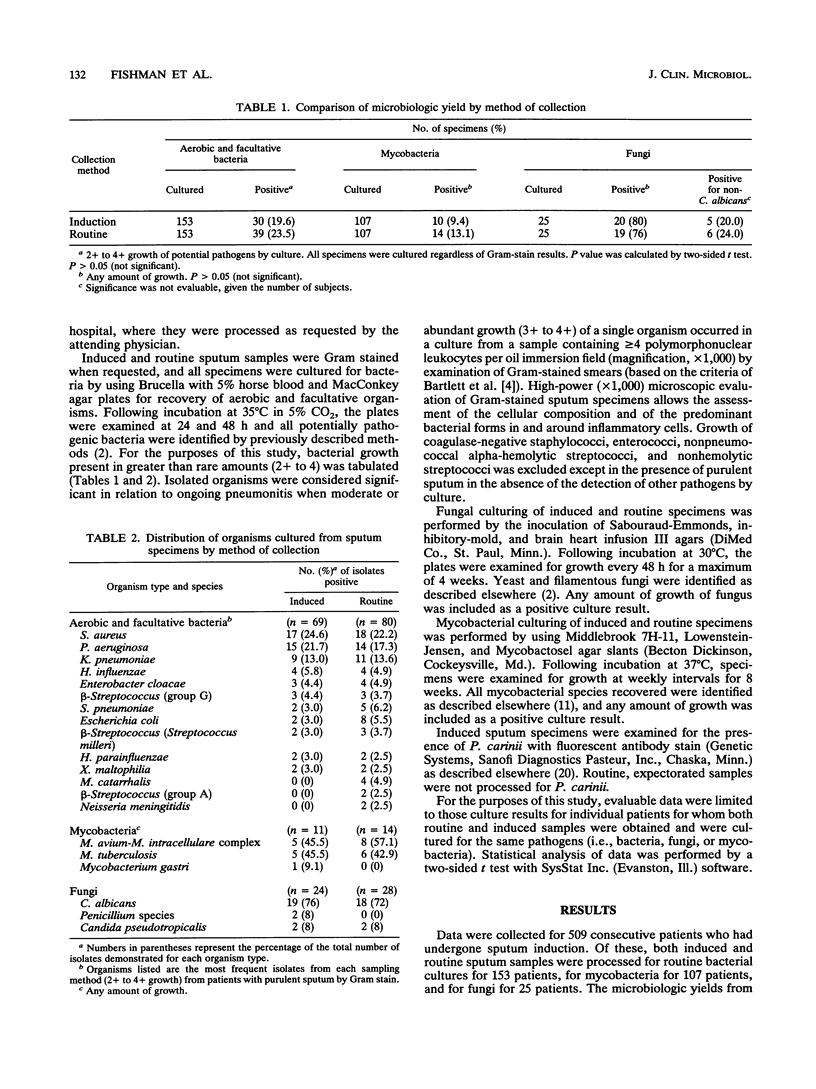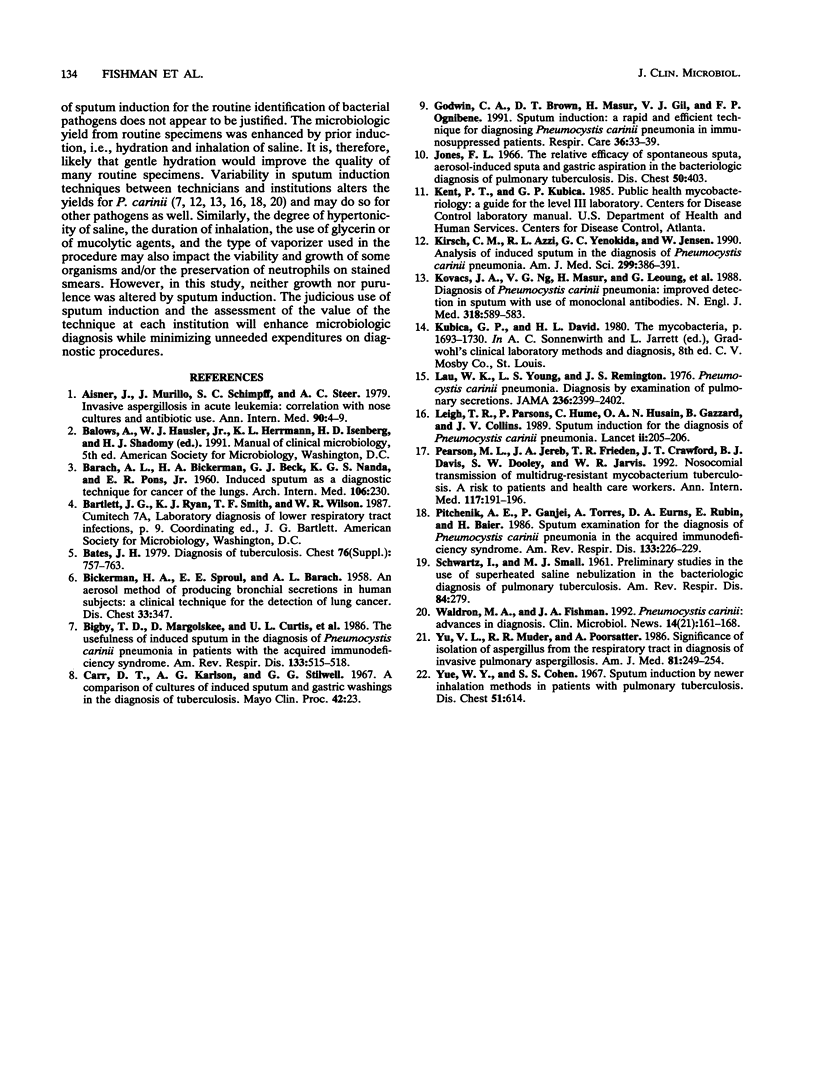Abstract
The optimal diagnostic approach to pneumonia provides a rapid microbiologic identification of pulmonary pathogens by the least invasive means. The technique of sputum induction has been useful in the evaluation of patients with Pneumocystis carinii or mycobacterial pneumonia. It is not known whether induced sputum samples are preferable for the detection of pathogens other than P. carinii or mycobacteria. Microbiologic yields were evaluated from identically processed induced and conventional sputum samples collected from 509 consecutive patients. No statistically significant differences were found between the microbiologic yields of induced and spontaneous sputum samples. Bacterial pathogens were isolated in 19.6% of induced and 23.5% of routine specimens. Mycobacteria were cultured from 13.1% of routine and 9.4% of induced specimens. Non-Candida albicans fungi grew from 24% of routine and 20% of induced specimens. The process of sputum induction with aerosolized hypertonic saline did not alter either the purulence or the bacterial quantitation of Gram-stained sputum specimens. Sputum induction has been useful for the cytologic diagnosis of malignancy, for the diagnosis of pneumocystosis and tuberculosis, and in patients unable to spontaneously produce sputum samples. The use of induced sputum samples for the diagnosis of other infections may not be necessary when routine sputum specimens are available.
Full text
PDF



Selected References
These references are in PubMed. This may not be the complete list of references from this article.
- Aisner J., Murillo J., Schimpff S. C., Steere A. C. Invasive aspergillosis in acute leukemia: correlation with nose cultures and antibiotic use. Ann Intern Med. 1979 Jan;90(1):4–9. doi: 10.7326/0003-4819-90-1-4. [DOI] [PubMed] [Google Scholar]
- BARACH A. L., BICKERMAN H. A., BECK G. J., NANDA K. G., PONS E. R., Jr Induced sputum as a diagnostic technique for cancer of the lungs and for mobilization of retained secretions. Arch Intern Med. 1960 Aug;106:230–236. doi: 10.1001/archinte.1960.03820020070010. [DOI] [PubMed] [Google Scholar]
- BICKERMAN H. A., SPROUL E. E., BARACH A. L. An aerosol method of producing bronchial secretions in human subjects: a clinical technic for the detection of lung cancer. Dis Chest. 1958 Apr;33(4):347–362. doi: 10.1378/chest.33.4.347. [DOI] [PubMed] [Google Scholar]
- Bates J. H. Diagnosis of tuberculosis. Chest. 1979 Dec;76(6 Suppl):757–763. doi: 10.1378/chest.76.6_supplement.757. [DOI] [PubMed] [Google Scholar]
- Bigby T. D., Margolskee D., Curtis J. L., Michael P. F., Sheppard D., Hadley W. K., Hopewell P. C. The usefulness of induced sputum in the diagnosis of Pneumocystis carinii pneumonia in patients with the acquired immunodeficiency syndrome. Am Rev Respir Dis. 1986 Apr;133(4):515–518. doi: 10.1164/arrd.1986.133.4.515. [DOI] [PubMed] [Google Scholar]
- Carr D. T., Karlson A. G., Stilwell G. G. A comparison of cultures of induced sputum and gastric washings in the diagnosis of tuberculosis. Mayo Clin Proc. 1967 Jan;42(1):23–25. [PubMed] [Google Scholar]
- Jones F. L., Jr The relative efficacy of spontaneous sputa, aerosol-induced sputa, and gastric aspirates in the bacteriologic diagnosis of pulmonary tuberculosis. Dis Chest. 1966 Oct;50(4):403–408. doi: 10.1378/chest.50.4.403. [DOI] [PubMed] [Google Scholar]
- Kirsch C. M., Azzi R. L., Yenokida G. G., Jensen W. A. Analysis of induced sputum in the diagnosis of Pneumocystis carinii pneumonia. Am J Med Sci. 1990 Jun;299(6):386–391. doi: 10.1097/00000441-199006000-00006. [DOI] [PubMed] [Google Scholar]
- Kovacs J. A., Ng V. L., Masur H., Leoung G., Hadley W. K., Evans G., Lane H. C., Ognibene F. P., Shelhamer J., Parrillo J. E. Diagnosis of Pneumocystis carinii pneumonia: improved detection in sputum with use of monoclonal antibodies. N Engl J Med. 1988 Mar 10;318(10):589–593. doi: 10.1056/NEJM198803103181001. [DOI] [PubMed] [Google Scholar]
- Lau W. K., Young L. S., Remington J. S. Pneumocystis carinii pneumonia. Diagnosis by examination of pulmonary secretions. JAMA. 1976 Nov 22;236(21):2399–2402. doi: 10.1001/jama.236.21.2399. [DOI] [PubMed] [Google Scholar]
- Leigh T. R., Parsons P., Hume C., Husain O. A., Gazzard B., Collins J. V. Sputum induction for diagnosis of Pneumocystis carinii pneumonia. Lancet. 1989 Jul 22;2(8656):205–206. doi: 10.1016/s0140-6736(89)90382-6. [DOI] [PubMed] [Google Scholar]
- Pearson M. L., Jereb J. A., Frieden T. R., Crawford J. T., Davis B. J., Dooley S. W., Jarvis W. R. Nosocomial transmission of multidrug-resistant Mycobacterium tuberculosis. A risk to patients and health care workers. Ann Intern Med. 1992 Aug 1;117(3):191–196. doi: 10.7326/0003-4819-117-3-191. [DOI] [PubMed] [Google Scholar]
- Pitchenik A. E., Ganjei P., Torres A., Evans D. A., Rubin E., Baier H. Sputum examination for the diagnosis of Pneumocystis carinii pneumonia in the acquired immunodeficiency syndrome. Am Rev Respir Dis. 1986 Feb;133(2):226–229. doi: 10.1164/arrd.1986.133.2.226. [DOI] [PubMed] [Google Scholar]
- SCHWARTZ I., SMALL M. J. Preliminary studies in the use of superheated saline nebulization in the bacteriologic diagnosis of pulmonary tuberculosis. Am Rev Respir Dis. 1961 Aug;84:279–280. doi: 10.1164/arrd.1961.84.2.279. [DOI] [PubMed] [Google Scholar]
- Yu V. L., Muder R. R., Poorsattar A. Significance of isolation of Aspergillus from the respiratory tract in diagnosis of invasive pulmonary aspergillosis. Results from a three-year prospective study. Am J Med. 1986 Aug;81(2):249–254. doi: 10.1016/0002-9343(86)90259-7. [DOI] [PubMed] [Google Scholar]
- Yue W. Y., Cohen S. S. Sputum induction by newer inhalation methods in patients with pulmonary tuberculosis. Dis Chest. 1967 Jun;51(6):614–620. doi: 10.1378/chest.51.6.614. [DOI] [PubMed] [Google Scholar]


